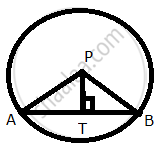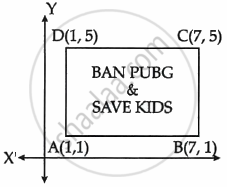Advertisements
Advertisements
Question
Show that P(– 2, 2), Q(2, 2) and R(2, 7) are vertices of a right angled triangle
Solution
Distance between two points = `sqrt((x_2 - x_1)^2 + (y_2 - y_1)^2`
By distance formula,
PQ = `sqrt([2 - (-2)]^2 + (2 - 2)^2`
= `sqrt((2 + 2)^2 + (0)^2`
= `sqrt((4)^2`
= 4 .....(i)
QR = `sqrt((2 - 2)^2 + (7 - 2)^2`
= `sqrt((0)^2 + (5)^2`
= `sqrt((5)^2`
= 5 ......(ii)
PR = `sqrt([2 -(-2)]^2 + (7 - 2)^2`
= `sqrt((2 + 2)^2 + (5)^2`
= `sqrt((4)^2 + (5)^2`
= `sqrt(16 + 25)`
= `sqrt(41)`
Now, PR2 = `(sqrt(41))^2` = 41 ......(iii)
Consider, PQ2 + QR2
= 42 + 52
= 16 + 25
= 41 ......[From (i) and (ii)]
∴ PR2 = PQ2 + QR2 ......[From (iii)]
∴ ∆PQR is a right angled triangle. ......[Converse of Pythagoras theorem]
∴ Points P, Q, and R are the vertices of a right angled triangle.
APPEARS IN
RELATED QUESTIONS
If the point A(0, 2) is equidistant from the points B(3, p) and C(p, 5), find p. Also, find the length of AB.
Find the value of x, if the distance between the points (x, – 1) and (3, 2) is 5.
Name the type of quadrilateral formed, if any, by the following points, and give reasons for your answer:
(- 1, - 2), (1, 0), (- 1, 2), (- 3, 0)
ABC is a triangle and G(4, 3) is the centroid of the triangle. If A = (1, 3), B = (4, b) and C = (a, 1), find ‘a’ and ‘b’. Find the length of side BC.
Find the values of x, y if the distances of the point (x, y) from (-3, 0) as well as from (3, 0) are 4.
If A (-1, 3), B (1, -1) and C (5, 1) are the vertices of a triangle ABC, find the length of the median through A.
Find the distance between the following point :
(p+q,p-q) and (p-q, p-q)
Find the distance of a point (12 , 5) from another point on the line x = 0 whose ordinate is 9.
Find the distance between the points (a, b) and (−a, −b).
Find the distance between the origin and the point:
(-8, 6)
The distance between the points (3, 1) and (0, x) is 5. Find x.
Find a point on the y-axis which is equidistant from the points (5, 2) and (-4, 3).
Point P (2, -7) is the centre of a circle with radius 13 unit, PT is perpendicular to chord AB and T = (-2, -4); calculate the length of AB.

Find the distance of the following points from origin.
(5, 6)
Show that the quadrilateral with vertices (3, 2), (0, 5), (- 3, 2) and (0, -1) is a square.
If the point (x, y) is at equidistant from the point (a + b, b – a) and (a-b, a + b). Prove that ay = bx.
Find distance between points P(– 5, – 7) and Q(0, 3).
By distance formula,
PQ = `sqrt(square + (y_2 - y_1)^2`
= `sqrt(square + square)`
= `sqrt(square + square)`
= `sqrt(square + square)`
= `sqrt(125)`
= `5sqrt(5)`
|
In a GPS, The lines that run east-west are known as lines of latitude, and the lines running north-south are known as lines of longitude. The latitude and the longitude of a place are its coordinates and the distance formula is used to find the distance between two places. The distance between two parallel lines is approximately 150 km. A family from Uttar Pradesh planned a round trip from Lucknow (L) to Puri (P) via Bhuj (B) and Nashik (N) as shown in the given figure below.
|
Based on the above information answer the following questions using the coordinate geometry.
- Find the distance between Lucknow (L) to Bhuj (B).
- If Kota (K), internally divide the line segment joining Lucknow (L) to Bhuj (B) into 3 : 2 then find the coordinate of Kota (K).
- Name the type of triangle formed by the places Lucknow (L), Nashik (N) and Puri (P)
[OR]
Find a place (point) on the longitude (y-axis) which is equidistant from the points Lucknow (L) and Puri (P).
The distance between the points (0, 5) and (–3, 1) is ______.
Read the following passage:
|
Use of mobile screen for long hours makes your eye sight weak and give you headaches. Children who are addicted to play "PUBG" can get easily stressed out. To raise social awareness about ill effects of playing PUBG, a school decided to start 'BAN PUBG' campaign, in which students are asked to prepare campaign board in the shape of a rectangle: One such campaign board made by class X student of the school is shown in the figure.
|
Based on the above information, answer the following questions:
- Find the coordinates of the point of intersection of diagonals AC and BD.
- Find the length of the diagonal AC.
-
- Find the area of the campaign Board ABCD.
OR - Find the ratio of the length of side AB to the length of the diagonal AC.
- Find the area of the campaign Board ABCD.


